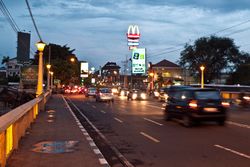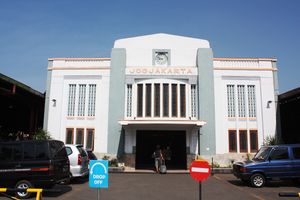يوگياكرتا
يوگياكرتا | |
|---|---|
City | |
 The Tugu monument in 2007 | |
| الشعار: Memayu Hayuning Bawono | |
| الإحداثيات: 7°48′5″S 110°21′52″E / 7.80139°S 110.36444°E | |
| Country | Indonesia |
| Province | Yogyakarta Special Region |
| الحكومة | |
| • Governor | ISKS Hamengkubuwono X |
| • Mayor | Haryadi Suyuti |
| المساحة | |
| • City | 32٫5 كم² (12٫5 ميل²) |
| • العمران | 1٬114٫16 كم² (430٫18 ميل²) |
| التعداد (2010) | |
| • City | 388٬088 |
| • الكثافة | 12٬000/km2 (31٬000/sq mi) |
| • العمرانية | 2٬389٬200 |
| • الكثافة العمرانية | 2٬100/km2 (5٬600/sq mi) |
| منطقة التوقيت | UTC+7 (WIB) |
| الموقع الإلكتروني | www.jogjakota.go.id |
يوگياكرتا (إندونيسية: Yogyakarta؛ English: /ˌjɒɡjəˈkɑrtə/ أو /ˌjoʊɡjəˈkɑrtə/،[1] ملايو: [jɔɡjaˈkarta]؛ وأيضاً جوگجا Jogja، جوگجاكرتا Jogjakarta) هي مدينة وعاصمة يوگياكرتا المنطقة الخاصة في جزيرة جاوة في إندونسيا. وتشتهر بأنها مركز الفن والثقافة الجاوية الكلاسيكية الرفيعة مثل الباتيك، الباليه، الدراما، الموسيقى، الشعر ومسرح العرائس. وكانت يوگياكرتا عاصمة إندونسيا أثناء الثورة الوطنية الإندونيسية من 1945 وحتى 1949. أحد مناطق يوگياكرتا، كوتاگده، كانت عاصمة سلطنة مطرم من 1575 وحتى 1640. وقد سُميت المدينة على اسم المدينة الهندية أيوديا من ملحمة الرامايانا. فكلمة يوگيا تعني 'مناسب'، و كرتا، 'مزدهر' (أي 'مدينة يليق بها الازدهار').[2]
التاريخ
مملكة مطرم (8th - 10th Century CE)
According to Canggal inscription dated 732, the area traditionally called as "Mataram" and become the capital of Medang Kingdom, identified as Mdang i Bhumi Mataram established by King Sanjaya. Mataram become the center of a refined and sophisticated Javanese Hindu-Buddhist culture, for about three centuries its heartland in Kewu Plain (southern slope of Mount Merapi) around Prambanan witnessed the construction of numerous candi including Borobudur and Prambanan.
امبراطورية ماجاپاهيت (1293 - 1527)
سلطنة مطرم (1575 - 1620)
بعد معاهدة جيانتي (1745 - 1945)
During the reign of Pakubuwono II the civil war was broke out in Mataram Sultanate.
The Yogyakarta Sultanate was established as a result of the Treaty of Giyanti (Perjanjian Gianti) by Prince Mangkubumi, who later ascend the throne as Sultan Hamengkubuwono I. Officially, the creation of Yogyakarta Sultanate is dated to 7 October 1756 as a result of civil war among the princes of The Mataram Sultanate. This civil war marked the end of the Mataram Sultanate and resulted in the birth of the Yogyakarta Sultanate and the Surakarta Sunanate .

However, in later years both of the heir of Mataram, the Yogyakarta Sultanate and the Surakarta Sunanate confined their power and were reduced as Dutch East Indies protectorate kingdoms under the crown of the Kingdom of Netherlands, identified as Vorstenlanden Mataram.
Republic of Indonesia era (1945 - present)
In 1942 the Japanese Empire invaded Dutch East Indies and ruled Java until they were defeated in 1945. Sukarno proclaimed the independence of Indonesian Republic on August 1945. Sultan Hamengkubuwono IX promptly send a letter to Sukarno expressing his support to the newly born nation of Indonesia and acknowledge Yogyakarta Sultanate as part of Indonesian Republic. The Sunanate of Surakarta also doing the same, and both of the Javanese kingdoms realm are awarded special status as Special Region within Indonesian Republic. However because leftist anti-royalist uprising in Surakarta, the Sunanate of Surakarta lost its special administrative status in 1946 and absorbed into Central Java Province.
الجغرافيا

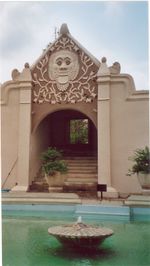
The area of the city of Yogyakarta is 32.5 km². While the city spreads in all directions from the kraton (the Sultan's palace), the core of the modern city is to the north, centring around Dutch colonial-era buildings and the commercial district. Jalan Malioboro, with rows of pavement vendors and nearby market and malls, is the primary shopping street for tourists in the city, while Jalan Solo, further north, is a shopping district more frequented by locals. At the southern end of Malioboro, on the east side is the large local market of Beringharjo, not far from Fort Vredeburg a restored Dutch fort.
Administration
DI Yogyakarta is actually a special district on the provincial level, of which Greater Yogyakarta is located within. The regencies of Bantul and Sleman have population densities far higher than the surrounding countryside (over 1,500 per square kilometer) and effectively are bedroom communities of Yogyakarta. Within Greater Yogyakarta lies the municipality of Yogyakarta, called Kota Yogyakarta. The tiny Kota represents the core of Yogyakarta.
| Name | Capital | Area (km²) | Population 2000 Census |
Population 2010 Census |
|---|---|---|---|---|
| Bantul Regency | Bantul | 506٫86 | 781٬000 | 910٬572 |
| Sleman Regency | Sleman | 574٫80 | 901٬400 | 1٬090٬567 |
| Yogyakarta City | Yogyakarta (city) | 32٫50 | 396٬700 | 388٬088 |
| Gunung Kidul Regency | Gunung Kidul | |||
| Kulon Progo Regency | Kulon Progo | |||
| Greater Yogyakarta | 1٬114٫16 | 2٬079٬100 | 2٬389٬200 |
The municipality (kota) is divided into 14 districts (kecamatan).
- Gondokusuman
- Jetis
- Tegalrejo
- Umbulharjo
- Kotagede
- Mergangsan
- Ngampilan
- Danurejan
- Kraton
- Wirobrajan
- Pakualaman
- Mantrijeron
- Gedongtengen
- Gondomanan
Arts and culture
Yogyakarta has strong communities in:
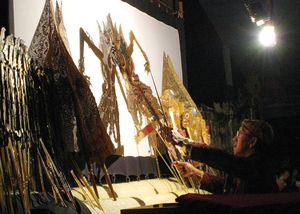
- Silver work,
- Traditional leather puppetry used for shadow plays (wayang kulit),
- Contemporary puppetry and theatre, for example Papermoon Puppet Theatre[3]
- Making batik dyed fabric.
- Gamelan music, including the unique style Gamelan Yogyakarta, which developed in the courts.
- Visual artists including Taring Padi community in Bantul, that produces art prints using a technique called [بحاجة لمصدر]
Demography and language
Most population is Javanese, but being a student city, there are also significant population of people from other ethnicities in Indonesia. This status makes Yogyakarta as one of the most heterogeneous cities in terms of ethnicity in Indonesia. [بحاجة لمصدر]
Education

Yogyakarta is well known as home of Gadjah Mada University,[4] one of Indonesia's most prominent state universities. The others public university in Yogyakarta are Yogyakarta State University,[5] Sunan Kalijaga State Islamic University,[6] Indonesia Arts Institute.[7] This city also houses several well-known private universities such as Muhammadiyah University of Yogyakarta,[8][9] Islamic University of Indonesia,[10] Atma Jaya University[11] and Sanata Dharma University.[12]
Museums
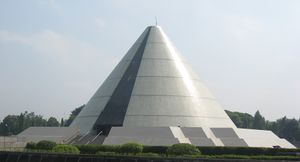
Transportation
Airport
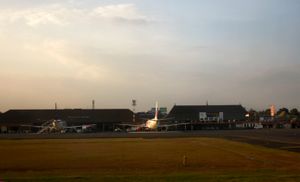
Rail
الطرق
الحافلات

المناخ
| بيانات المناخ لـ Yogyakarta | |||||||||||||
|---|---|---|---|---|---|---|---|---|---|---|---|---|---|
| الشهر | ينا | فب | مار | أبر | ماي | يون | يول | أغس | سبت | أكت | نوف | ديس | السنة |
| متوسط القصوى اليومية °س (°ف) | 29 (84) |
29 (84) |
29 (85) |
31 (87) |
30 (86) |
30 (86) |
29 (85) |
30 (86) |
31 (87) |
31 (88) |
30 (86) |
29 (85) |
30 (86) |
| متوسط الدنيا اليومية °س (°ف) | 22 (72) |
22 (72) |
22 (72) |
22 (72) |
22 (72) |
21 (70) |
21 (69) |
21 (69) |
22 (71) |
22 (72) |
22 (72) |
22 (72) |
22 (71) |
| متوسط تساقط الأمطار mm (inches) | 350 (13.8) |
330 (13.0) |
310 (12.2) |
210 (8.3) |
120 (4.7) |
80 (3.1) |
40 (1.6) |
20 (0.8) |
30 (1.2) |
90 (3.5) |
220 (8.7) |
340 (13.4) |
2٬180 (85.8) |
| Source: http://www.weatherbase.com/weather/weather.php3?s=35869&refer=&units=metric | |||||||||||||
السياحة
Because of its proximity to world famous Borobudur and Prambanan temples, also because having unique Javanese court Kraton culture of Kraton Yogyakarta, Yogyakarta has become the second most important tourist destination in Indonesia after Bali. Most tourists come to Yogyakarta as an accommodation base on visiting Borobudur and Prambanan and also for its strong Javanese culture and tradition. This makes it prominent among other Javanese cities, along with Surakarta or Solo, a city lying about 64 km to the east, Yogyakarta is the centre of Javanese culture.
Sister cities
 Gangbuk-gu, South Korea
Gangbuk-gu, South Korea Baalbek, Lebanon
Baalbek, Lebanon Huế, Vietnam
Huế, Vietnam Hefei, China
Hefei, China Kyoto, Japan
Kyoto, Japan Paramaribo, Suriname
Paramaribo, Suriname Bonn, ألمانيا
Bonn, ألمانيا
انظر أيضاً
الهامش
- ^ "Yogyakarta | Define Yogyakarta at Dictionary.com". Dictionary.reference.com. Retrieved 5 June 2011.
- ^ E.M. Pospelov, Geograficheskie nazvaniya mira (Moscow: Russkie slovari, 1998), p. 138.
- ^ Papermoon Puppets
- ^ UGM.ad.id
- ^ [1]
- ^ [2]
- ^ [3]
- ^ "Muhammadiyah University of Yogyakarta".
- ^ On December 19, 1994 by the Decree No. 102 / D0/1994 of the Ministry of Education and Culture of the Republic of Indonesia IKIP Muhammadiyah Yogyakarta was to switch function to Ahmad Dahlan University. "Sejarah Universitas Ahmad Dahlan (History of Ahmad Dahlan University)".
- ^ UII.ac.id
- ^ UAJY.ac.id
- ^ USD.ac.id
12. gudeg.net 13. Lintas Berita Yogyakarta
وصلات خارجية
 Yogyakarta travel guide from Wikivoyage
Yogyakarta travel guide from Wikivoyage- Official website
- Pages using gadget WikiMiniAtlas
- Short description with empty Wikidata description
- Coordinates not on Wikidata
- Pages using infobox settlement with unknown parameters
- Articles containing إندونيسية-language text
- Pages using Lang-xx templates
- Pages with plain IPA
- المقالات needing additional references from December 2010
- كل المقالات needing additional references
- مقالات ذات عبارات بحاجة لمصادر
- Articles with hatnote templates targeting a nonexistent page
- Pages with empty portal template
- يوگياكرتا
- أماكن مأهولة في يوگياكرتا
- مدن إندونسيا
- عواصم مقاطعات إندونسيا



